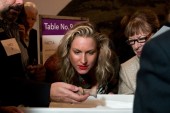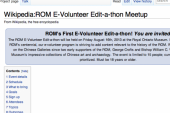
Fred Herzog, Man With Bandage (1968) Fred Herzog at the Museum of Contemporary Canadian Art Highlights from the Contact Photography Festival French philosopher Roland Barthes famously proclaimed every photograph a momento mori, a mnemonic for our mortality, a reminder that one day each of us will die. His mournful take on the medium is rooted in the personal connection we have with the past of our own photographs. When we rifle through our parent’s and grandparent’s photo-albums, there are only memories of loss there, images of the people and places we’ll never see again. Even the photographs of strangers, be they a collection of vintage prints on display in a gallery or a bundle of snapshots discovered in the recesses of a junk shop, strike an elegiac tone. Things have changed somewhat since the 1970s when Barthes was writing. The olden days aren’t so clearly demarcated by black and white, the Instamatic has been usurped by the instant upload, and our personal image banks now reside on hard drives rather than between hard covers. The revolution in visual culture that was sparked by the invention of the camera continues apace and nowhere are the ever-expanding ripples of the possibilities of picture-taking more evident than during the month of May when Toronto pays host to the Contact Photography Festival and almost every available vertical surface – and even some horizontal ones (see below) – is taken up by the photographic arts. Vancouver photographer Fred Herzog, the main attraction of one of the festival’s feature exhibitions, neatly ties together the past and present in arresting images of urban life from the middle of the last century. After arriving in Canada from Germany in 1952, Herzog worked as a medical photographer but spent his spare time amassing hundreds of snapshots of his new hometown’s vibrant streetscape, capturing the changing face of the city in its buildings, cars, and people. It’s easy to be nostalgic about these scenes, scanning them for classic fashion and design – the type of post-war, pre-counterculture style that defines the cool-factor of Mad Men. In a strange twist, the trickle-down modernity of the age’s ethos – the futurism of clean lines, neon signs, and aerodynamic cars – has kept it relevant through however many retro-movements we’ve experienced since then. Herzog distinguishes himself as a photographer in his use of colour; the emergent art photography of the time preferred “serious” black and white, while colour was the palette for advertising. This choice encourages viewers to see his photographs less as memorials to what once was and more as forward-looking glimpses to how things would soon be. William Faulkner’s line, “The past is not dead. In fact, it’s not even past,” comes to mind when looking at the variety of Canadians who happen in front of Herzog’s lens: a black father and daughter in their Sunday best walking through Chinatown, a Sikh man watched through a pawn shop window by a toy Lone Ranger, an interracial couple gambling at a street fair. The people and the places (rapidly disappearing in relentlessly gentrifying Vancouver but still lingering in certain corners) of our most cosmopolitan city are not in fact fading into the distance, but pleasantly familiar and ever present – so much so that a more recent print is not immediately apparent and a second glance is required to recognize the contemporary graffiti in the background. Connecting us to our past, providing a sense of history, tracing our lineage through clothes we remembered our great aunts’ wearing or the now-faded ads painted on walls we pass by without a thought, this is what photography can do. This is why we treasure it. In the hands of an artist with an eye like Fred Herzog, a photograph is not a lament that time is running out, but an affirmation that life goes on. Contrary to Barthes, his implicit message is: Remember, you are alive. OTHER CONTACT HIGHLIGHTS: Scarlett Hooft Graafland, Wrapped (2007) Dynamic Landscapes at the Museum of Contemporary Canadian Art Four corners of the globe are explored in a colourful exhibition of international talent at MOCCA, but this isn’t your standard National Geographic take on the wonders of the world. From Arctic surrealism to “dream villas” in India, these artists forgo the documentary tradition to craft evocative scenes with their unique locales as canvas. Suzy Lake at the University of Toronto Art Centre & Paul Petro Contemporary Art Lake is our hometown photo-conceptualist, a pioneer in the art of reflecting on identity and the phenomenology of the body through a variety of gambits in self-portraiture. A well-deserved survey of her work can be found at U of T. More recent updates on her performative practice are on display at Paul Petro. Edward Burtynsky at the Institute for Contemporary Culture (ROM) & Nicholas Metivier Gallery Canada’s most famous photographer since Yousuf Karsh merits a retrospective viewing of his past work at the ROM, tied together through the easy theme of our ubiquitous addiction to oil, while his commercial gallery presents far less damning, dare-we-say “painterly” aerial shots of curvaceous farm plots in Spain. Lynne Cohen, Untitled (2010) Lynne Cohen at Olga Korper Gallery Lynne Cohen does for institutional interiors what Edward Burtynsky does for industrial landscapes. Empty of people, these strange settings elicit a queasy combination of dread and delight. Lee Goreas & James Nizam at Birch Libralato One takes heroic pictures of well-worn golf balls; the other constructs temporary sculptures in a soon-to-be demolished housing project. Together they encourage the viewer to rethink the disposable materials that pass through our lives and accumulate in forgotten corners. Robert Bourdeau at Stephen Bulger Gallery You can keep your hipster-gone-wild snapshot aesthetic. You can keep your intricately constructed cinematic tableaus. Robert Bourdeau goes old school with perfectly composed landscape studies that even your philistine friends will admit are art. Public Installations on billboards, walls, and floors throughout the city To point out a few: Elle Flanders and Tamara Sawatzky’s bucolic Israeli landscape in the MOCCA courtyard depicts the site of a long demolished Palestinian town, Kevin Schmidt’s picture of an apocalyptic sign at the top of the world can be found on The Power Plant’s south face, Robert Longo’s convulsing bodies along the sidewalk by Metro Hall should be familiar to fans of his early paintings, and Alain Paiement’s overhead interiors on the floor of Brookfield Place should appeal to the voyeur in each of us.














